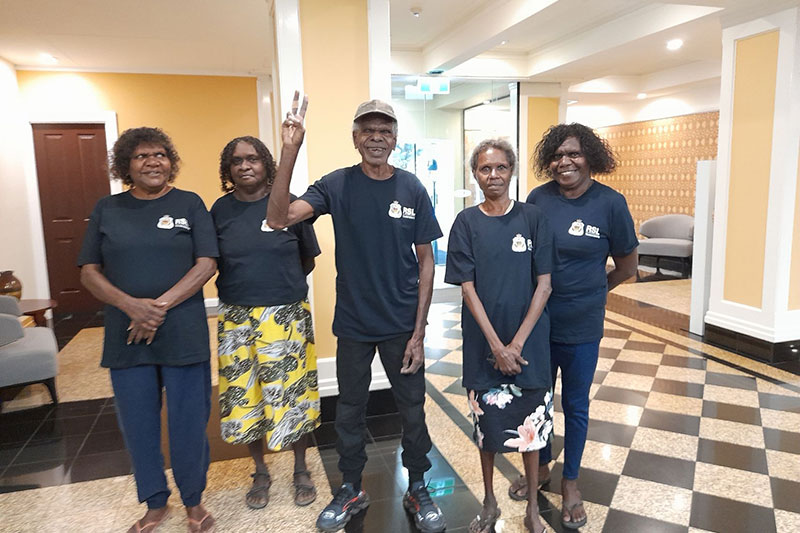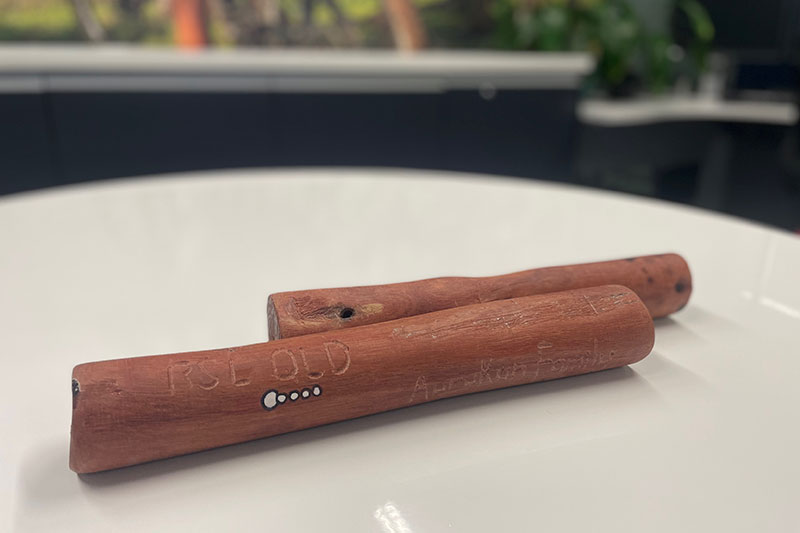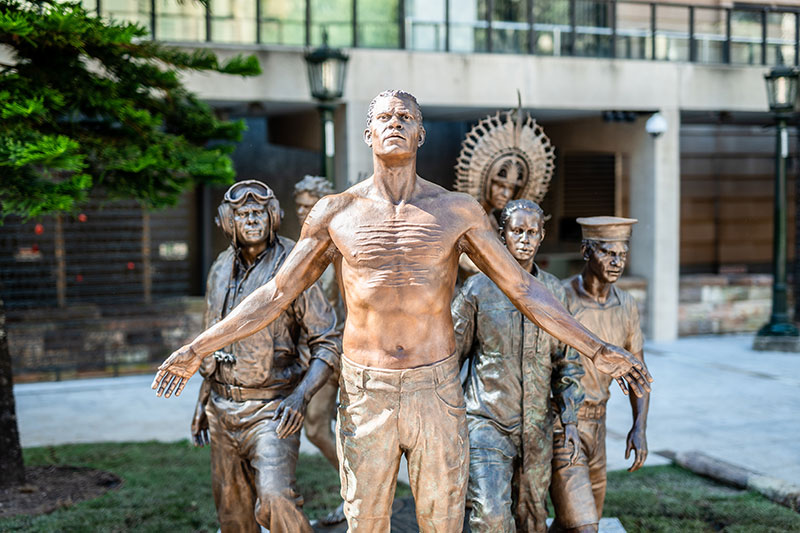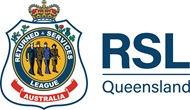
How one remote Indigenous community left a giant footprint in the heart of Brisbane
08 July 2022- First Nations
Aboriginal Elders from Aurukun visited Brisbane for the unveiling of a memorial dedicated to Indigenous veterans.
Almost 2000 kilometres north of the Queensland capital, in one of Australia’s most remote and rugged communities, a group of Aboriginal Elders were excitedly packing.
The destination was Brisbane, the occasion was a monumental trip to honour their heritage, and the mode of transport was a couple of cars followed by a couple of flights.
For some, it would be their first time taking a plane. For others, it would be their first time seeing the capital’s bright lights. And for all of them, it would be the first time their far-flung community would receive overdue acknowledgment for military services rendered decades earlier.
Just a couple of days later, the Aurukun mob stood shoulder to shoulder with government officials, veterans and their families and hundreds of spectators as an Indigenous military statue dedicated to that service was unveiled in ANZAC Square.
The statue of six Indigenous Australian figures in dramatic poses would add a new chapter to the nation’s rich military history book and leave a permanent footprint in the heart of the city.
The following day, at RSL Queensland’s Indigenous Veterans’ Ceremony, the mob from Aurukun would proudly share their previously untold stories – casting a light on the unique role they played from one of the country’s most isolated lands.
Where the mangroves meet the Gulf of Carpentaria

Aurukun Elders (left to right) Aunty Roxanne Yunkaporta, Aunty Maree Kalkeeyorta, Uncle Christopher Woolla, Aunty Dinah Walmbeng and Aunty Selina Wolmby
Perched near the north west coast of Queensland’s Cape York Peninsula, and comprising some 7,500 square kilometres, Aurukun Shire is about as far off the beaten track as it gets.
Boasting one of the wildest environments on the planet, it’s a place where tropical rainforests meet rugged eucalyptus forests before merging into a sea of coastal mangroves and palm-fringed beaches.
The scorched earth is quenched only when the wet season arrives with gusto in November – and it’s then that the roads turn into rivers - cranking the region’s Accessibility/Remoteness Index of Australia rating up another notch.
Aurukun Shire already sits in the highest ARIA category there is: “very remote”.
Up there, 93.7 per cent of the population is Indigenous, boasting a proud mix of largely Wik, Wik Way and Kugu people with the predominant language being Wik Mungkan.
While English is taught in schools, 86.7% of the population speak a traditional Indigenous language at home.
From the untamed tropics to bustling Brissy

The clap sticks gifted to RSL Queensland by the Aurukun Elders
Considering just how isolated those wild lands are, bringing a small group of Aurukun veterans or their next of kin to Brisbane was quite the feat, said First Nations mentor Elaine Gallagher.
Elaine, a steely veteran from Myanmar, has been a close friend of the tribe since meeting them during a stint working for the mines up north. And that firm friendship led to her being honoured with an Aboriginal skin name by the traditional landowners.
“I’m passionate about helping vulnerable communities, and particularly our First Nations families. So earlier this year, when I came across an RSL Queensland initiative to bring remote Indigenous veterans to Brisbane for a special ceremony, I immediately reached out to Aurukun elder Uncle Christopher Woolla,” she said.
“I knew this was a rare chance to get a truly remote mob to the city.
Working with RSL Queensland, Elaine guided the group down to Brisbane and said through that trip, historic wounds began to heal.
“Aurukun country is one of the most dangerous places in Australia, but these are a wonderful people that would do anything for you and to be flown down and taken care of after all they’ve given to this nation has gone a long way to repairing the trust between these communities,” Elaine said.
“During the ceremony, statues of Indigenous service people were unveiled in the heart of ANZAC Square and soon, the Aurukun mob were given the chance to speak. Afterwards, they were gifted these RSL Queensland t-shirts. It was a small thing, but they were just so proud to wear them.
“In return, they gave a beautiful pair of traditional clap sticks to RSL Queensland.”
History made

The Indigenous Memorial Statue in ANZAC Square
The presence of the Aurukun people at that momentous statue unveiling in ANZAC Square was the final piece of an intricate puzzle painstakingly arranged by Australian Army’s Second Indigenous Elder and President of the Aboriginal and Torres Strait Memorial Committee Queensland, Aunty Lorraine Hatton and her dedicated team.
A Quandamooka Elder from Minjerribah (North Stradbroke Island) and Mulgumpin (Moreton Island) of the Noonuccal and Ngughi tribes in South-East Queensland, Aunty Lorraine maintained a distinguished and successful career serving 21 years in the Army before retiring in 2007.
Ever since, she’s lent her considerable might to a host of meaningful projects that include the Indigenous Memorial Statue.
“This project actually started in 2013 but I didn’t come on board until November 2015, so I spent just over six years working on it, alongside a dedicated team,” she said.
“The reason it took so long was because of funding … a lot of people were hesitant to get involved and it wasn’t until a prominent philanthropist showed faith in us that others followed.
“And the reason they were all hesitant is because it was an Aboriginal and Torres Strait Islander statue. We kept getting asked: ‘why do you need a statue just for them?’ And it’s a question that is still often asked.
“My answer is this: our defence family has many stories and Indigenous military is a part of this family. We only have to look at the various memorials around Australia to see the many different stories within our military history. We have a memorial for EOD service dogs, we have a memorial for Simpson and his donkey, so why not a statue for us?
“Our military history isn’t widely known. And by bringing this statue to life, we’re sharing another rich page in Australia’s military book. We’re not taking away from anyone else but adding to it. There are Indigenous military memorials in South Australia, New South Wales and even at the Australian War Memorial in Canberra.”
The incredible multi-year effort was wrapped up in time for this year’s National Reconciliation Week and was officially unveiled by Queensland Premier Annastacia Palaszczuk on Friday, 27 May.
Depicting Aboriginal and Torres Strait Islander men and women from Queensland who served and sacrificed their lives for the nation, the bronze statue paints a powerful image.
Want to stay informed? Subscribe today and get the latest news, services, events and more direct to your email inbox.
Related News
Loading

